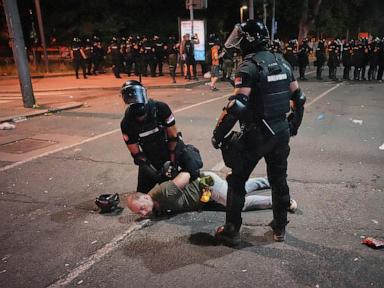Serbian police have detained 79 university students and other protesters as they dismantled street blockades in multiple cities, marking the latest chapter in the ongoing dissent against President Aleksandar Vucic’s populist administration. The interventions occurred late Wednesday and early Thursday in Belgrade, Novi Sad, Nis, and Novi Pazar, with officers in riot gear taking action. Authorities have denied allegations of police brutality, while protest organizers claim that peaceful demonstrators were injured during the police response.
Witnesses reported to local media that riot police used batons and shields against the protesters, resulting in four students being hospitalized, including one with a broken clavicle. The Interior Ministry stated that four officers were injured and a police vehicle was damaged, asserting that the officers “acted in accordance with the law” during the unrest.
Background of the Protests
The tensions in Serbia have been escalating since a massive rally last Saturday, which called for early parliamentary elections. The demonstration, attended by tens of thousands in Belgrade, ended in clashes between riot police and protest groups. Despite the pressure, President Vucic has refused to call for a snap election, maintaining his stance amidst over eight months of continuous protests.
The protests initially erupted in November following a tragic incident in Novi Sad, where a renovated rail station canopy collapsed, killing 16 people. This event sparked allegations of corruption and negligence in state infrastructure projects, fueling public outrage. While parliamentary and presidential elections are scheduled for 2027, the demand for earlier elections has been a central theme of the protests.
Government Response and Criticism
President Vucic has characterized the protests as “terror” and attempts to destabilize the state, stepping up governmental measures to suppress the demonstrations. Critics, however, argue that Vucic has increasingly adopted authoritarian tactics since coming to power over a decade ago, curbing democratic freedoms while allowing corruption and organized crime to thrive. Vucic has consistently denied these accusations.
Serbia’s bid to join the European Union adds another layer of complexity to the situation. Although formally seeking EU membership, Vucic’s administration has simultaneously cultivated close ties with Russia and China, raising questions about Serbia’s geopolitical orientation.
Expert Opinions and Historical Context
Political analysts suggest that the current unrest in Serbia reflects broader regional trends where populist leaders face growing public dissatisfaction. According to Dr. Ivan Markovic, a political science professor at the University of Belgrade, “The protests in Serbia are part of a wider pattern seen in Eastern Europe, where citizens demand greater transparency and accountability from their governments.”
Historically, Serbia has experienced periods of political instability, particularly in the post-Yugoslav era. The current protests echo past movements where citizens have rallied against perceived governmental overreach and corruption.
Looking Forward
As the protests continue, the Serbian government faces mounting international scrutiny. The European Union has expressed concern over the reports of police violence and the broader implications for Serbia’s democratic processes. Meanwhile, the protest organizers vow to persist in their efforts, calling for increased international attention to their cause.
The coming weeks will be critical in determining whether the government will alter its approach or if the protests will gain further momentum. Observers are closely watching how these developments might influence Serbia’s political landscape and its aspirations for EU membership.
